Ayurvedic nutrition
Ayurveda is founded on the principle of the 5 elements (Pancha Mahabhutas):
- Akasha or ether
- Vayu or air
- Agni or fire
- Jala or water
- Prithivi or earth
These 5 elements combine in our body to form what are called the 3 doshas: vata, pitta and kapha. Each dosha is constituted of two of the 5 elements:

Each dosha is also made up of two of the five elements:
- Vata is made of the air and ether elements
- Pitta is made of the fire and water elements
- Kapha is made of the earth and water elements.
Ayurvedic nutrition is also built up on the concept of the 6 tastes (Rasa) and considers that these are constituted of the 5 elements:
- Madhura or sweet, is constituted of the earth and water elements
- Amla or sour is constituted of the earth and fire elements
- Lavana or salty is constituted of the fire and water elements
- Katu or spicy is constituted of the fire and air elements
- Kashaya or astringent is constituted of the air and earth elements
- Tikta or bitter is constituted of the air and ether element.


One of the principles of ayurveda is that what is similar will increase whereas the opposite elements will diminish.
Thus, a principle of ayurvedic nutrition is that each taste has either a reducing/balancing or an increasing/aggravating action on each of the 3 doshas:
- Le dosha Vata (air and ether) is balanced by sweet, sour and salty tastes and aggravated by bitter, astringent and spicy tastes.
- Le dosha Pitta (fire and water) is balanced by sweet, bitter and astringent tastes and aggravated by spicy, sour and salty tastes.
- Le dosha Kapha (earth and water) is balanced by spicy, bitter and astringent tastes and aggravated by sweet, salty and sour tastes.
Besides, in ayurveda, it is considered that diseases grow from the digestive organs where the 3 doshas are seated:
- Le dosha vata seats in the colon
- Le dosha pitta seats in the small intestine
- Le dosha kapha seats in the stomach.
Thus, as soon as one of the three doshas is accumulating and aggravating in its seat, it provokes digestive disorders, generating in the short term the appearance of toxins (ama), and in the medium and long term diseases in our organism.
Hence, by following the principles of Ayurvedic nutrition, we can restore and maintain the balance of the 5 elements and the 3 doshas in our body, regulate and balance our digestive fire (agni), and thus prevent the occurrence of toxins (ama) and diseases in our body.
The 3 Gunas: Sattva, Rajas and Tamas – how do they relate with our diet?
In ayurveda, particular attention is paid to the quality of the food, as food which is rich in vital energy (prana) is fresh, seasonal, cultivated without pesticides or chemical fertilisers, but also cooked and eaten with a favourable inner disposition, that is to say with positive emotions and thoughts. And also, according to our ayurvedic constitution (Vata, Pitta or Kapha).
There are three important qualities in Ayurveda which are called Gunas, and which enable us to absorb more or less vital energy: sattva, rajas and tamas:
Sattva is the energy of light, source of purity, which gives us knowledge, joy and love.
Rajas is the energy of power, which gives movement and animates matter.
Tamas is the principle of inertia, heaviness, lethargy and destruction.
Thus, Tamas is the energy that Rajas sets in motion so as to get to Sattva which is the quality which we try to reach through yoga and meditation.
All of the various types of food we eat have a different effect on our organism, and the nature of their nature have got an influence over our thoughts and emotions.
Tamasic food generates sloth, lack of motivation, inertia and excessive sleep.
Rajasic food generates constant agitation, impatience and agitated sleep.
Sattvic food generates a clear; lucid and peaceful mind, and a body which is in good health and where prana can flow correctly.

Besides the nature of food, the way tit is eaten can also influence the balance between the 3 gunas, such as:
- eating late in the evening or at night (when the sun has set or not yet risen)
- eating oversized portions
- eating while we are agitated or in a hurry
- eating while we have negative thoughts or feelings
- re-heating left-over food (which diminishes the amount of prana originally present in the food)
- eating at irregular times.
These bad habits can further the creation of toxins (ama) in our organism which will generate tamas.
Thus, one wants to have a sattvic diet, which will improve the quantity and the quality of our vital energy (prana), while stimulating its flow in our subtle energetic channels (nadis), so that our body be in good health and that our immunity (ojas) works best. This food is fresh, light, increases body and mind purity, as well as peacefulness, intelligence and helps us take clear and precise decisions. It is an alimentation which is rich in fruits, fresh and organic vegetables (what is raw has more prana), light legumes (lentils), whole grain cereals (red rice, ancient wheat…), raw milk (pasteurized milk is considered dead milk and toxic for the body), oleaginous fruit (nuts, almonds), non heated honey, ghee (clarified butter), and light and purifying spices (fennel, cardamom, saffron).
Food can balance our energetic, emotional and intellectual bodies
Food is digested and assimilated by our digestive fire (agni) and also thanks to one of Pitta’s sub-dosha which is called pachaka pitta. However, the quality of our food also has an influence over another sub-dosha of pitta named sadhaka pitta, which is responsible for the digestion of our emotions by the fire element.
Consequently, the quality of our diet and the way we cook our food has an influence over our different bodies. First, on the physical body (the quality of our digestion and of our tissues), on the energetic body (our vitality and the quality of the flow of prana in our nadis), on our emotional body (our ability to deal with our emotions), and finally on our mental body (our psyche, our perceptions and our thinking capacities).
Thus, a tamasic diet (with low prana, heavy, cold and dead) negatively influences our different bodies and our ability to use them in an optimal and balanced way.
On the other hand, a sattvic diet (rich in prana, light, pure and nutritious) positively influences our different bodies and our ability to use them in an optimal and balanced way. Such a diet balances the digestive fire (agni) and digestion (pachaka pitta), as well as a better digestion of our emotions and some emotional balance (saddhaka pitta), leaving space for a better ability to think to the best of our abilities, as well as a better discernment towards our psychic perceptions.
For yoga practice, we look for this balance of the emotional body so that all our psychic perceptions becorrect. In order to balance our emotional body, the purity of our food is very important and complements our yoga practice.




